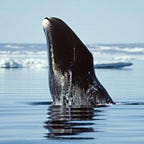A Season of Abundance: Spring and Summer in the Chukchi Corridor
by: Kathy Kuletz
Water and animals from the Bering Sea squeeze through the Bering Strait before entering the Chukchi Sea. From there the waters split to head north, west, or east; the eastern branch is where the Chukchi Corridor begins. The dictionary defines ‘corridor’ as a heavily traveled strip of land between two landscapes or cities, but it is also an apt description for this 50-mile wide strip of water offshore of northwest Alaska. As the name implies, this corridor is a passageway in the Chukchi Sea, flowing northward to the head of the underwater Barrow Canyon, near the village of Wainwright. The Alaska Coastal Current (ACC) flows through it, and along its path is nearly every form of Arctic wildlife, from year-round resident to migrant. About a dozen major rivers join the ACC along its journey, contributing to the corridor’s complexity and species richness.
Rounding Point Hope you’d pass the seabird colonies of Cape Lisburne, where tens of thousands of Black-legged Kittiwakes, Thick-billed and Common Murres, Horned and Tufted Puffins, and others flare out from their cliff edge nests to crisscross the corridor on foraging forays. Farther north and you’d dip into wide Ledyard Bay and pass Kasegaluk Lagoon, where you might see hundreds of spotted seals hauled out, then around Icy Cape. Between the Cape and the upper reaches of Barrow Canyon, which is rich from the sporadic influx of easterly-flowing Beaufort Sea waters, you’d encounter the continuous traffic of seabirds, sea ducks, and loons, while below would be whales, seals, walrus, and the occasional polar bear among ice floes.
In spring, polar bears prowl the ice-fast coast looking for seals, from small ribbon to massive bearded seals, while bowhead and beluga whales follow the string of polynyas arrayed off the coast. Seabirds also take advantage of the open leads, where surrounding ice protects from wind and waves and the underside of ice floes grow algae, attract plankton, and shelter juvenile fish –prey to the keen eyes of Glaucous Gulls, kittiwakes and short-timers like Ross’s and Ivory Gulls passing through on their circumpolar wanderings.
As ice breaks up and retreats, Gray Whales move in, and more birds join the flow, some migrating to dispersed coastal and inland nest sites, like the King, Common, Steller’s, and Spectacled Eiders, Long-tailed Ducks, Yellow-billed and Red-throated Loons. Tens of thousands of shorebirds of 19 species, like Dunlin, sandpipers and phalaropes, dot the barrier islands. Offshore a variety of alcids search shoals to find fish for their chicks. Later in summer and into fall birds finished with chick-rearing duties, like Crested and Least Auklets, even Ancient Murrelets, arrive to dive into walls of krill and copepods. Short-tailed Shearwaters from the southern hemisphere appear and in some years outnumber the locals.
There is still plenty of daylight up here in late summer, and late-blooming zooplankton and fat juvenile fish must make it worth the extra sojourn north. Arctic Terns and Red Phalaropes assemble from coastal and tundra nest sites and cruise the waters to pick out zooplankton or small capelin, sand lance, Arctic cod and juvenile herring, bulking up for their 10,000 mile journey south. The ice will soon return and by mid to late September the birds start trickling, then flooding south again, reversing the flow along the Chukchi Corridor, just ahead of winter.
About the author: Kathy Kuletz has studied seabird ecology since 1978, primarily as a biologist with the U.S. Fish and Wildlife Service, based in Anchorage, Alaska. As an expert on Arctic seabirds, she has been a senior scientist on many publications and long-term monitoring studies in the Arctic Ocean and Bering Sea.
